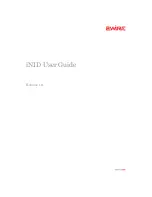
F–1
Appendix F. ETHERNET
NETWORK CONFIGURATION
F.1
Introduction
For
operations
requiring
Ethernet
‐
based
terrestrial
data
handling,
it
is
important
to
stress
the
importance
of
avoiding
Ethernet
looping
connection
problems
–
with
or
without
use
of
the
CDM
‐
750
in
redundancy.
These
issues
are
specifically
addressed
with
a
CDM
‐
750
redundancy
configuration
that
uses
Comtech
EF
Data’s
CRS
‐
170A
(L
‐
Band)
or
CRS
‐
180
(70/140
MHz)
1:1
Redundancy
Switches,
or
a
CRS
‐
500
M:N
Redundancy
System
in
1:N
redundancy.
Use
this
appendix
to
review
the
differing
methods
for
Ethernet
‐
based
data
handling
with
the
CDM
‐
750
Advanced
High
‐
Speed
Trunking
Modem.
F.2
Ethernet Routers and Switches
Routers
and
switches
allow
connection
of
one
or
more
computers
or
networked
devices
to
other
computers
or
network
devices.
Each
has
two
or
more
connectors,
called
physical
ports,
in
which
cables
connect
to
other
network
devices.
An
Ethernet
switch
examines
the
traffic
that
comes
across
it,
and
learns
where
particular
MAC
addresses
are.
An
Ethernet
switch
maintains
what
is
known
as
a
C
ontent
A
ddressable
M
emory
(
CAM
)
table,
listing
the
MAC
addresses
for
each
switch
port.
The
Ethernet
switch
uses
the
CAM
table
to
determine
where
to
forward
Ethernet
frames.
By
default,
Ethernet
switches
will
update
the
CAM
table
automatically;
for
example,
if
an
Ethernet
switch
sees
traffic
from
‘Machine
A’
coming
in
on
‘Port
2’,
it
now
knows
that
‘Machine
A’
is
connected
to
that
port,
and
that
traffic
destined
for
‘Machine
A’
needs
to
only
be
sent
to
that
port
and
not
any
of
the
others.
An
Ethernet
router
determines
where
to
forward
IP
traffic
based
upon
the
destination
IP
address
and
the
Route
table
entries
in
the
router.
An
Ethernet
router
can
be
programmed
to
understand
and
route
the
data
it
is
directed
to
handle;
for
example,
broadband
routers
include
the
ability
to
"hide"
computers
behind
a
type
of
firewall,
which
involves
slightly
modifying
the
packets
of
network
traffic
as
they
traverse
the
device.
All
routers
include
some
kind
of
user
interface
for
configuring
how
the
router
will
treat
traffic:
larger
routers
include
the
equivalent
of
a
full
‐
blown
programming
language
to
describe
how
they
should
operate,
as
well
as
the
ability
to
communicate
Содержание CDM-750
Страница 64: ...CDM 750 Advanced High Speed Trunking Modem Revision 2 Rear Panel Connections MN CDM750 3 20 Notes...
Страница 76: ...CDM 750 Advanced High Speed Trunking Modem Revision 2 Updating Firmware MN CDM750 4 12 Notes...
Страница 142: ...CDM 750 Advanced High Speed Trunking Modem Revision 2 Front Panel Operation MN CDM750 5 66 Notes...
Страница 178: ...CDM 750 Advanced High Speed Trunking Modem Revision 2 Ethernet based Remote Product Management MN CDM750 6 36 Notes...
Страница 224: ...CDM 750 Advanced High Speed Trunking Modem Revision 2 Appendix A MN CDM750 A 4 Notes...
Страница 227: ...CDM 750 Advanced High Speed Trunking Modem Revision 2 Appendix B MN CDM750 B 3 This page is intentionally blank...
Страница 234: ...CDM 750 Advanced High Speed Trunking Modem Revision 2 Appendix B MN CDM750 B 10 Notes...
Страница 256: ...CDM 750 Advanced High Speed Trunking Modem Revision 2 Appendix C MN CDM750 C 22 Notes...
Страница 280: ...CDM 750 Advanced High Speed Trunking Modem Revision 2 Appendix D MN CDM750 D 24 Notes...
Страница 300: ...2114 WEST 7TH STREET TEMPE ARIZONA 85281 USA 480 333 2200 PHONE 480 333 2161 FAX...
















































